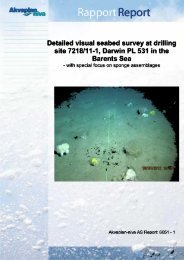A study of the priority substances of the Water Framework Directive ...
A study of the priority substances of the Water Framework Directive ...
A study of the priority substances of the Water Framework Directive ...
You also want an ePaper? Increase the reach of your titles
YUMPU automatically turns print PDFs into web optimized ePapers that Google loves.
..:::::::::: appendix c<br />
..:::102<br />
APPENDIX C<br />
Short list <strong>of</strong> words and terms<br />
Acute oral LD50: Acute lethal dose for 50 percent<br />
<strong>of</strong> a group <strong>of</strong> test animals (rats) within a<br />
defined period <strong>of</strong> time, <strong>of</strong>ten 24 hours. The dose<br />
is normally given in micrograms per gram body<br />
weight.<br />
BCF: Bio-concentration factor. Defined as <strong>the</strong><br />
concentration <strong>of</strong> a chemical in an organism<br />
(divided by <strong>the</strong> concentration in a reference<br />
compartment (e.g. food, surrounding water)).<br />
ClassLab: "Harmonised Classifications and<br />
Labelling for Substances, refers to <strong>the</strong><br />
Norwegian St<strong>of</strong>flisten. St<strong>of</strong>flisten has some<br />
information that is specific to Norway.<br />
EC50: Effect concentration. The concentration<br />
that gives effects on 50 percent <strong>of</strong> test animals<br />
within a given period <strong>of</strong> time.<br />
Half life: Half life (or DT50) is <strong>the</strong> time it takes<br />
for half <strong>the</strong> amount <strong>of</strong> a chemical to disappear.<br />
This may happen due to evaporation, hydrolysis,<br />
photo degradation, chemical degradation,<br />
degradation by bacteria etc. When using values<br />
for half life it should be taken into considera-<br />
A <strong>study</strong> <strong>of</strong> <strong>the</strong> <strong>priority</strong> <strong>substances</strong> <strong>of</strong> <strong>the</strong> <strong>Water</strong> <strong>Framework</strong> <strong>Directive</strong><br />
TA-2140/2005<br />
tion that chemicals which are easily degraded by<br />
for instance sunlight may be very persistent in<br />
groundwater or sediments, and that a chemical<br />
may be degraded via several routes simultaneously.<br />
Thus different half life values are given for each<br />
substance for depending on where <strong>the</strong> chemical<br />
is released and type <strong>of</strong> degradation.<br />
LC50: Lethal concentration (usually in water)<br />
for fish or invertebrates, <strong>the</strong> concentration<br />
required to kill 50 percent <strong>of</strong> a group <strong>of</strong> fish or<br />
invertebrates in a given time (normally 24 - 96<br />
hours)<br />
Log Kow:Log Octanol-<strong>Water</strong> Partitioning<br />
Coefficient. High Log Kow indicates a compound<br />
which will preferentially partition into<br />
soil organic matter ra<strong>the</strong>r than water.<br />
NOEL/NOAEL: No observed effect level / No<br />
observed adverse effects level. The highest<br />
amount <strong>of</strong> a substance that can be administered<br />
without any effects on <strong>the</strong> test animals.

















